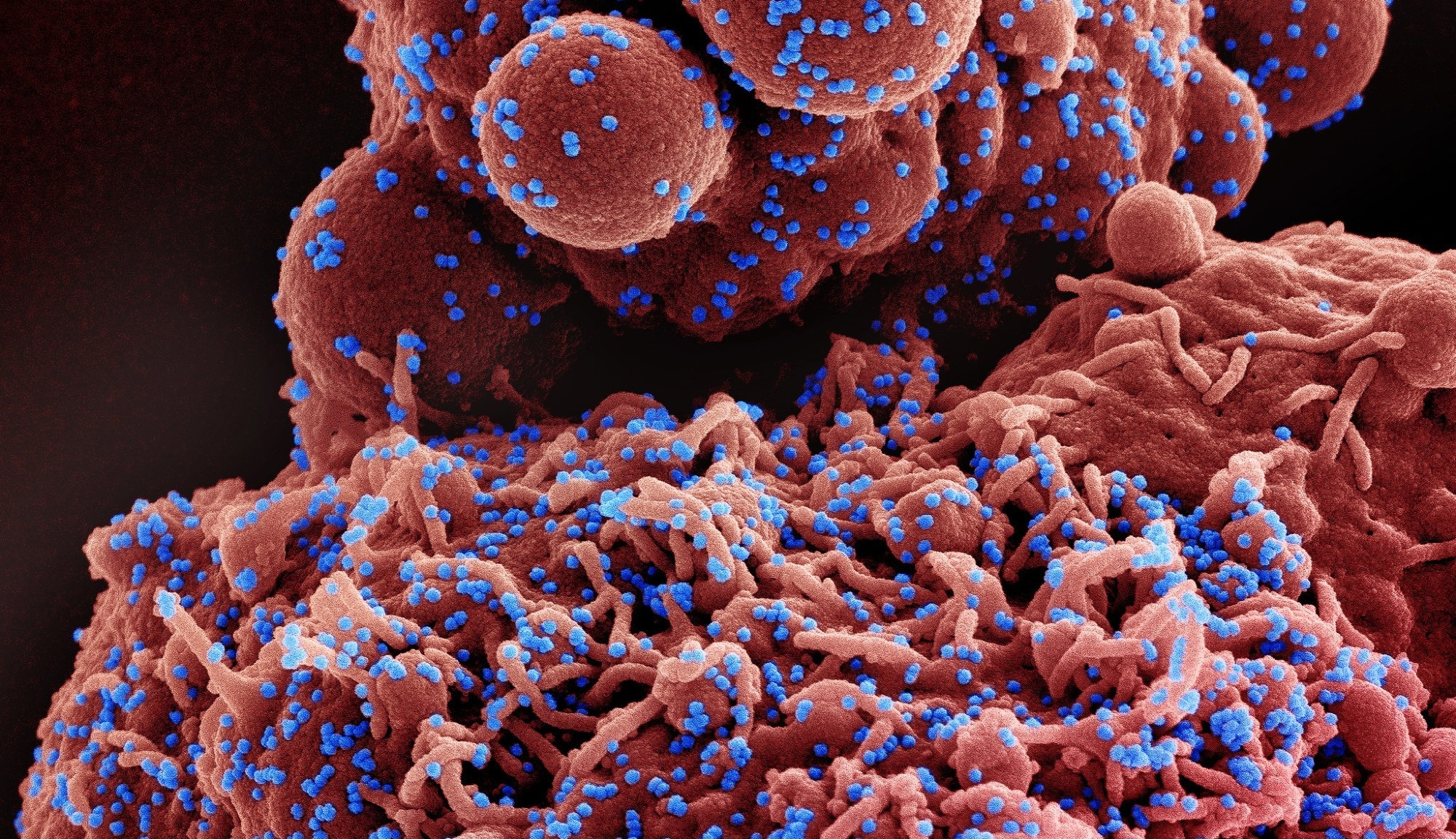Omicron is constantly evolving to give rise to novel sub-VOCs with greater transmissibility and immune evasiveness, making COVID-19 mitigation a challenging task. Varying immune-evasiveness of Omicron sub-VOCs allows the occurrence of novel SARS-CoV-2 infections. Analysis of immune escape of vaccination or infection-induced immune protection by novel VOCs and sub-VOCs could inform policy-making and guide the development of updated (COVID-19) vaccines.
 Study: Higher risk of SARS-CoV-2 Omicron BA.4/5 infection than of BA.2 infection after previous BA.1 infection, the Netherlands, 2 May to 24 July 2022. Image Credit: NIAID
Study: Higher risk of SARS-CoV-2 Omicron BA.4/5 infection than of BA.2 infection after previous BA.1 infection, the Netherlands, 2 May to 24 July 2022. Image Credit: NIAID
About the study
In the present study, researchers investigated probable reductions in infection or vaccination-induced immunity levels against Omicron BA.4/5 and Omicron BA.2 infections.
A SARS-CoV-2 infection-only method was used to evaluate the impact of prior anti-SARS-CoV-2 immunity levels against novel BA.4/5 and BA.2 infections between May 2 and July 24, 2022. Additionally, the team evaluated the effects of the VOC-wise duration between the prior and current case of COVID-19 and that of different VOC infections on the development of Omicron BA.4/5 and Omicron BA.2 infections.
SARS-CoV-2 spike (S) gene target failure (SGTF) was assessed using SARS-CoV-2-positive tests among community-dwelling individuals based on the reverse transcription-polymerase chain reaction (RT-PCR) results for SARS-CoV-2 S, open reading frame 1ab (ORF1ab) and nucleocapsid (N) genes. RT-PCR reports and national-level SARS-CoV-2 testing register data were linked for the analysis. The register comprised data on individual demographic parameters and the self-documented status of COVID-19 vaccination.
Individuals with prior SARS-CoV-2 infection ≥30 days prior to the current SARS-CoV-2 infection were included. Whole genome sequencing (WGS) was performed using SGTF samples to determine the causative variant among 7.3% (117 out of 1,609) prior infections with VOC data. For the remaining 93% (1,492 samples), the VOC was determined based on SGTF results and the date of SARS-CoV-2 testing. Logistic regression modeling was performed, and the adjusted odds ratios (aOR) were calculated, with data adjustments for the week of SARS-CoV-2 testing, sex, and age.
Results
During the study period, 26 % (n=7,052) of BA.2 infections and 74% (n=19,836) of BA.4/5 infections were identified. During the initial and last weeks, Omicron BA.4/5 caused 3.30% (18 out of 545) infections and 99% (2,543 out of 2,572) infections. BA.4/5-infected individuals were usually younger compared to BA.2-infected individuals. The fraction of individuals with current SARS-CoV-2 infections was more significant for Omicron BA.4/5 infections, weekly and during the entire study period.
Out of 9,836 cases of BA.4/5 infections, 31% (n=6,215) of individuals had prior COVID-19 history than 20% (1,408 out of 7,052) of Omicron BA.2-infected individuals. Similar results were obtained in the adjusted analyses, with aOR values of 1.4 and 1.6 among unvaccinated and vaccinated cases, respectively. Among individuals without prior COVID-19 history, no significant association was observed between the status of vaccination and Omicron BA.4/5 versus BA.2 infections (aOR values of 1.1 and 1.1 for primary vaccination and booster vaccination, respectively).

Proportion of cases infected with SARS-CoV-2 BA.2 (non-SGTF) and BA.4/5 (SGTF) who had previous infections (n = 26,888) and different vaccination histories (n = 17,391), per week, the Netherlands, 2 May–24 July 2022. SARS-CoV-2: severe acute respiratory syndrome coronavirus 2; SGTF: S gene target failure. The number of cases corresponding to each group is displayed within the bars.
Prior COVID-19 history enhanced the risk of BA.4/5 infections, compared with Omicron BA.2 infections (aOR 1.4). Among previously infected individuals, the duration between SARS-CoV-2 infections was shorted among BA.4/5-infected individuals than BA.2-infected individuals, with median intervals of 182 days versus 206 days, respectively).
COVID-19 vaccines conferred equivalent immune protection against infections by BA.2 and BA.4/5 sub-VOCs. Prior Omicron BA.1 infection history was more prevalent among BA.4/5-infected individuals (63%) than BA.2-infected individuals (44%). The findings indicated that Omicron BA.4/5 has a greater capacity to evade BA.1 infection-conferred immune protection than with other VOC-caused prior SARS-CoV-2 infections.
Notably, Omicron BA.1 infection showed associations with Omicron BA.4/5 infections instead of BA.2 infections (aOR of 1.9). For prior infections with other VOCs, except Omicron BA.2, Omicron BA.4/5 infection risks were more significant compared to the risk of Omicron BA.2 infections. The complete case analysis yielded similar findings, excluding COVID-19 cases lacking vaccination data from prior SARS-CoV-2 infection analysis.
Among 385 samples sequenced by SGTF, WGS verified 14% (n=52) Omicron BA.4 infection cases and 84% (n=322) Omicron BA.5 infection cases [positive predictive value (PPV) of 97.0% (n=374) of the SGTF analysis for detecting Omicron BA.4/5]. Among SGTF-sequenced samples, the percentage of Omicron BA.5 infections increased as time passed. Non-SGTF findings strongly correlate with Omicron BA.2 and a 98.0% PPV (485 out of 495 cases).
Pre-VOC period was defined as that between January 18 (initiation of data retrieval) and February 17, 2021, by non-SGTF analysis. The Alpha wave was considered between January 18 and September 27, 2021, by SGTF analysis. The Delta wave was considered between June 20, 2021, and January 7, 2022, by non-SGTF analysis. BA.1 wave was considered between November 23, 2021, and April 9, 2022, by SGTF analysis, and that of BA.2 between January 29, 2022, and the end of the study period by non-SGTF analysis.
Overall, the study findings showed that prior SARS-CoV-2 infection-induced immunity conferred more significant protection against Omicron BA.2 infections than Omicron BA.4/5 infections, indicating that the BA.4/5 sub-VOC had a greater capacity to evade prior COVID-19-induced immunity. COVID-19 vaccines conferred equivalent immune protection against infections by BA.4/5 and BA.2.
Journal reference:
- Andeweg Stijn P, de Gier Brechje, Vennema Harry, van Walle Ivo, van Maarseveen Noortje, Kusters Nina E, de Melker Hester E, Hahné Susan JM, van den Hof Susan, Eggink Dirk, Knol Mirjam J. Higher risk of SARS-CoV-2 Omicron BA.4/5 infection than of BA.2 infection after previous BA.1 infection, the Netherlands, May 2 to July 24 2022. Euro Surveill. 2023;28(7):pii=2200724. DOI: https://doi.org/10.2807/1560-7917.ES.2023.28.7.2200724, https://www.eurosurveillance.org/content/10.2807/1560-7917.ES.2023.28.7.2200724